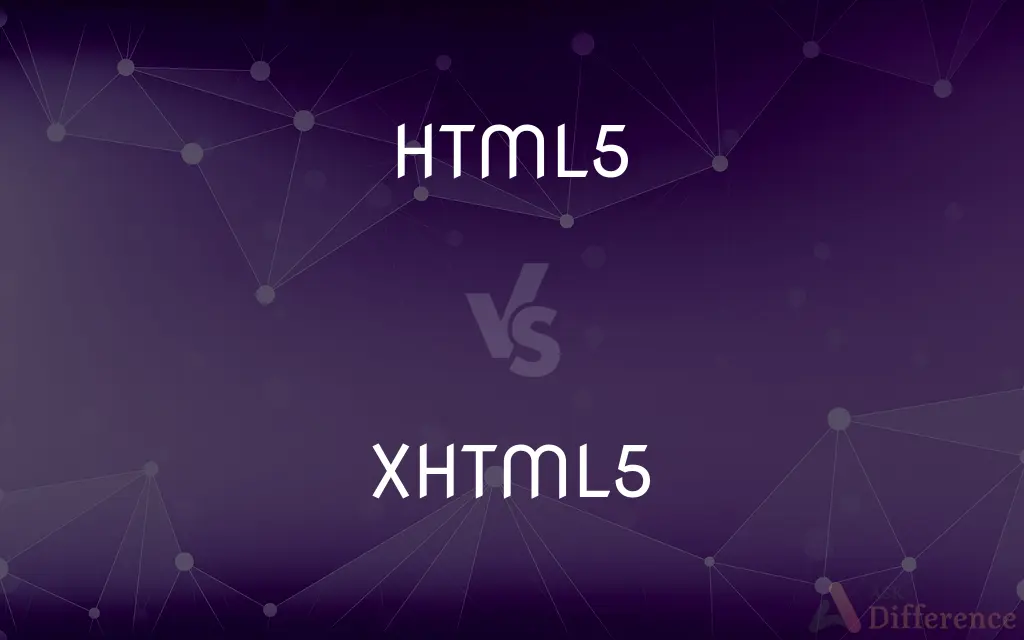HTML5 vs. XHTML5 — What's the Difference?
By Tayyaba Rehman & Urooj Arif — Published on February 4, 2024
HTML5 is a flexible and forgiving markup language for structuring web content, while XHTML5 is a stricter variant of HTML5, enforcing XML syntax for enhanced consistency and compatibility.

Difference Between HTML5 and XHTML5
Table of Contents
ADVERTISEMENT
Key Differences
HTML5 allows a more forgiving syntax, making it user-friendly for developers, while XHTML5 enforces strict adherence to XML syntax, requiring all elements to be properly nested and closed. This ensures a more consistent and error-free codebase, but also demands more precision during development.
When it comes to error handling, HTML5 is designed to be lenient, often allowing browsers to render pages even with some markup errors, whereas XHTML5 is uncompromising, with even small mistakes potentially leading to rendering issues. This strictness of XHTML5 promotes rigorous coding standards but can be less forgiving for beginners.
HTML5 is typically served with the text/html MIME type, ensuring broad compatibility across all browsers without the need for XML parsing, while XHTML5 requires the application/xhtml+xml MIME type, which leverages XML’s robust parsing rules to enforce code structure but can lead to compatibility concerns with older browsers.
In HTML5, the DOM can be more flexible, allowing for slight inconsistencies in the document structure, while XHTML5’s adherence to XML results in a more strict and consistent DOM. This makes XHTML5 preferable in environments where document structure and consistency are paramount, such as in XML-based data processing.
HTML5’s lenient syntax can lead to quicker development and easier debugging for web projects, catering to a wide range of skill levels among developers. In contrast, XHTML5’s strict rules can result in a steeper learning curve and more meticulous debugging process, but the resultant code is often more robust and universally compatible.
ADVERTISEMENT
Comparison Chart
Syntax Flexibility
Forgiving and flexible
Strict and rigorous
Error Handling
Lenient, renders with mistakes
Strict, errors may prevent rendering
MIME Type
Text/html
Application/xhtml+xml
Document Structure
Flexible DOM structure
Strict and consistent DOM structure
Development Suitability
User-friendly for all levels
Demands precision, suitable for experts
Compare with Definitions
HTML5
HTML5 is a versatile backbone of modern web development, supporting multimedia, graphical content, and improved performance.
With HTML5, animations and graphic-intensive games can run smoothly in browsers without additional software.
XHTML5
XHTML5 is designed for developers who require precision and adherence to standards, ensuring that web documents are both highly functional and consistently interpretable.
XHTML5’s stringent parsing rules make it an ideal choice for projects where document structure and data integrity are critical.
HTML5
HTML5 is the latest evolution of the standard HTML, introducing new elements and APIs for more dynamic and rich web content.
The video tag in HTML5 simplifies the embedding of videos into web pages without third-party plugins.
XHTML5
XHTML5 provides a hybrid solution, blending the rich multimedia support of HTML5 with the rigorous structure of XML.
XHTML5 allows the integration of SVG graphics inline with HTML, ensuring a seamless combination of visual and structural precision.
HTML5
HTML5 is a responsive and adaptive technology, enabling web content to function seamlessly across various devices.
HTML5 ensures that a website will look and function properly, whether it is accessed from a smartphone, tablet, or desktop.
XHTML5
XHTML5 is a stricter variant of HTML5, combining the flexibility of HTML5 with the stringent syntax of XML.
XHTML5 ensures that all tags are properly closed, making the code more predictable and less prone to errors.
HTML5
HTML5 is a markup language used for structuring and presenting content on the World Wide Web.
HTML5 allows web developers to create complex, interactive websites that are both functional and aesthetically pleasing.
XHTML5
XHTML5 is an application of XML, inheriting XML’s robust parsing and consistency rules to create well-structured web documents.
In XHTML5, every element and attribute name is case-sensitive, reflecting its XML foundation.
HTML5
HTML5 is an open standard, fostering innovation and collaboration in the development of the modern, interactive web.
HTML5's canvas element has revolutionized online graphics, allowing developers to render detailed visualizations directly in the browser.
XHTML5
XHTML5 enforces strict syntax and error handling, promoting high standards in web document structure and compatibility.
XHTML5’s strict syntax means that developers must write cleaner, more organized code, reducing the risk of browser incompatibility.
Common Curiosities
What is HTML5?
HTML5 is the latest version of HTML, designed to support multimedia and graphical content on the web without the need for proprietary plugins.
How does XHTML5 handle errors?
XHTML5 is strict; errors in the markup can prevent the entire page from rendering, encouraging developers to write error-free code.
How does HTML5 handle errors?
HTML5 is designed to be forgiving, often allowing web pages to render even when there are syntax errors in the markup.
What is XHTML5?
XHTML5 is a stricter form of HTML5, applying XML's strict syntax rules to HTML5 content to ensure well-formed and error-free code.
Are HTML5 documents compatible with all browsers?
HTML5 is widely supported across modern browsers, though some older versions may not support all features.
Can HTML5 and XHTML5 be used interchangeably?
While they share many features, they are not interchangeable due to differences in syntax rules and error handling.
Are XHTML5 documents compatible with all browsers?
XHTML5 is well-supported in modern browsers, but older browsers may require a proper MIME type to render XHTML5 correctly.
Can HTML5 and XHTML5 be used with other programming languages?
Yes, both can be integrated with languages like CSS for styling and JavaScript for functionality.
Is XHTML5 more complex than HTML5?
XHTML5 can be seen as more complex due to its strict syntax and requirement for well-formed code.
Do HTML5 and XHTML5 support multimedia content?
Yes, both support multimedia content natively, including audio, video, and graphical elements.
Can I use plugins with HTML5 or XHTML5?
While you can, both HTML5 and XHTML5 aim to reduce the need for third-party plugins by providing native support for most common web functionalities.
Is there a performance difference between HTML5 and XHTML5?
Performance differences are generally negligible, though XHTML5’s strict parsing may impact how quickly a browser can render content.
How do I choose between HTML5 and XHTML5 for my project?
HTML5 for more flexibility and easier development, and XHTML5 for strict structure and adherence to XML standards.
How important is document structure in XHTML5?
Document structure is critical in XHTML5 due to its adherence to XML's strict rules regarding element nesting and closure.
How do HTML5 and XHTML5 handle mobile responsiveness?
Both are well-equipped for creating mobile-responsive designs, though this also depends on proper CSS and JavaScript implementation.
Share Your Discovery

Previous Comparison
Nexium vs. Omeprazole
Next Comparison
Flow Control vs. Error ControlAuthor Spotlight
Written by
Tayyaba RehmanTayyaba Rehman is a distinguished writer, currently serving as a primary contributor to askdifference.com. As a researcher in semantics and etymology, Tayyaba's passion for the complexity of languages and their distinctions has found a perfect home on the platform. Tayyaba delves into the intricacies of language, distinguishing between commonly confused words and phrases, thereby providing clarity for readers worldwide.
Co-written by
Urooj ArifUrooj is a skilled content writer at Ask Difference, known for her exceptional ability to simplify complex topics into engaging and informative content. With a passion for research and a flair for clear, concise writing, she consistently delivers articles that resonate with our diverse audience.
















































